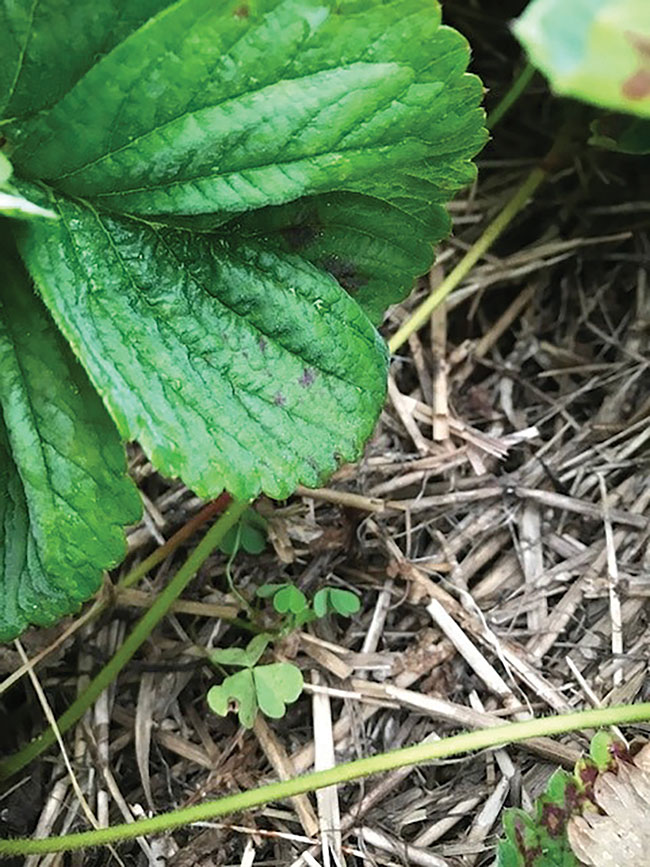
Features
Chemicals
Focus on: Berries
Fruit
Weeds
Group 14 herbicide trials in strawberries
April 5, 2022 By Perennia
 Strawberries in Nova Scotia are subject to unique challenges when it comes to weed control.
Photo courtesy of Sonny Murray.
Strawberries in Nova Scotia are subject to unique challenges when it comes to weed control.
Photo courtesy of Sonny Murray. Most strawberry growers in Nova Scotia experience unique challenges when it comes to weed control. With recent label expansions to include strawberries for many Group 14 herbicides, the field research team at Perennia, a provincial development agency focused on agri-food industry support and growth in Nova Scotia, explored herbicide options to control weeds unique to strawberry crops in the province through a field trial during the 2020 and 2021 growing seasons.
“With weed control being a major challenge in field production, we wanted to see how these group 14 active ingredients would control weeds that are unique to our area, including wood sorrel, field violet, sandwort, and scentless chamomile,” says Sonny Murray, berry specialist and trial lead.
Group 14 herbicides are a diverse group of products in their control of weeds. Also known as PPO inhibitors or cell membrane disruptors, some are active on weeds only if applied pre-emergence and give a residual control. Other products in this group, such as oxyfluorfen and fomesafen, work post-emergence on weeds in the two- to four-leaf stage. All Group 14 herbicides tend to be weak on grasses.
Fields for the trial sites were selected that were going into their second harvest year, and had even and heavy weed pressure. The treatments were all applied after the strawberries had shown the characteristic leaf drop and reddening for plants going dormant for the winter. The trial design used a standard randomized complete block design with four reps. Straw was then applied shortly after treatment. Visual weed control and phytotoxicity ratings were collected in the spring and until harvest was completed the following year. Treatments included fomesafen, sulfentrazone, flumioxazin and oxyfluorfen, and tank-mixes of oxyfluorfen plus flumioxazin, flumioxazin plus clopyralid and flumioxazin plus fomesafen.
The data is still being analyzed, but at first glance the team is pleasantly surprised at the control oxyfluorfen, sulfentrazone and flumioxazin provide on wood sorrel and field violet. Although more site years are needed, the trial has shown that tank-mixing select products can give excellent weed control of emerged seedlings and will provide good residual activity for four to six weeks in the spring after the straw is removed. Fomesafen also was shown to provide good control of newly emerged swamp smartweed. Both flumioxazin and sulfentrazone controlled eastern black nightshade through harvest the following year. No phytotoxicity was noted between the treatments, even in the tank-mix treatments, which would be characterized by discoloration and stunting of growth for this group of herbicides. The team is planning on expanding this demonstration trial over several growing seasons but is pleased with the results to date.
Capitalizing on weed control in late fall, after the strawberry plants have gone dormant, gives growers a head start on weed control in the spring and goes a long way to getting through harvest with a weed-free field, especially on early berry varieties. “Being able to control weeds chemically drastically reduces labour costs, and frees that labour up to do other timely jobs on the farm,” says Curtis Millen of Millen Farms in Great Village, N.S. “Having local weed control data on our specific weeds that are only found in the Maritimes gives us the confidence that we can use these products in our production system.”
Perennia is a provincial development agency, based in Nova Scotia, which is focused on agri-food industry support and growth. Their mission is to support growth, transformation, and economic development in Nova Scotia’s agriculture, seafood, and food and beverage sectors. To assist this development, Perennia has an agriculture team of over 20 employees. For more information, visit perennia.ca.
Print this page